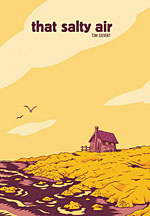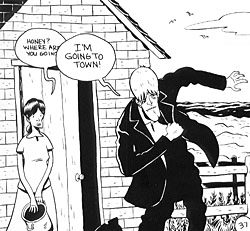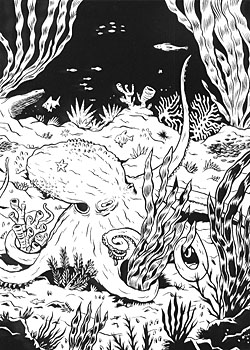 By Tim Sievert
By Tim Sievert
120 pages, black and white
Published by Top Shelf Productions
What is it about the ocean that seems to inspire so many works of literature? Maybe it’s because it, unlike land, is part of the world that we still haven’t really conquered. We visit it and travel through it, but the ecosystems and order of life within the ocean is one without mankind living in it, one that most people still don’t really understand. It’s probably why Tim Sievert chose it as a backdrop for his debut graphic novel That Salty Air. When you need a nemesis that is both living and inanimate, and both logical and irrational, it’s hard to go wrong with the sea.
Hugh and Maryanne live on the edge of the sea, outside of the local town. Hugh fishes for a living, and treats the ocean with a great amount of respect and reverence. When tragedy strikes Hugh, though, his love for the sea is transformed into hatred. Now Maryanne has to try and pull Hugh out of his spiral of despair and revenge, but things may have progressed so far that someone will have to pay the ultimate price for his actions.
 In some ways, That Salty Air reminded me of Moby Dick. There’s the obvious parallel of both being in a nautical setting, but there’s more to it than just that. The comparison probably came about because That Salty Air has Hugh’s need for revenge being focused on the sea, one that quickly turns into a dangerous obsession. It’s an interesting transformation for Hugh, especially serving in sharp contrast to Hugh’s earlier easy-going demeanor. Unfortunately, one you take that part away from Hugh there’s not really much to his character; both he and Maryanne come across as a bit two-dimensional, and it’s hard to really empathize with either of their plights.
In some ways, That Salty Air reminded me of Moby Dick. There’s the obvious parallel of both being in a nautical setting, but there’s more to it than just that. The comparison probably came about because That Salty Air has Hugh’s need for revenge being focused on the sea, one that quickly turns into a dangerous obsession. It’s an interesting transformation for Hugh, especially serving in sharp contrast to Hugh’s earlier easy-going demeanor. Unfortunately, one you take that part away from Hugh there’s not really much to his character; both he and Maryanne come across as a bit two-dimensional, and it’s hard to really empathize with either of their plights.
There’s also an element of magical realism running throughout That Salty Air. The creatures of the ocean certainly behave in a slightly incredible manner throughout the book, serving almost like a combination of a mute Greek chorus and the actual embodiment of a higher power. Accepting the magical realism nature of the book is, I think, somewhat critical to enjoying That Salty Air. Once it became more clear, Maryanne and Hugh’s actions seemed less like a cliché and more like they were part of a greater whole, a sequence of events that they can’t really break free from. In a book where bargains are being made with an octopus, one almost feels like you’re reading a fable transformed into modern times.
 The art was definitely the high point of That Salty Air for me. Sievert’s drawings of the bottom of the ocean are gorgeous, from a pod of whales swimming gracefully through its depths to scenes of danger and death underneath the waves. There’s a gentle flow about the art there, and honestly a portfolio from Sievert of nothing but water crashing up on the rocks and the occasional fish swimming by would be just fine in my book. That’s not to say that the rest of the art isn’t good, though. I like how Sievert draws his main characters as average and plain (and perhaps even a little ugly in the case of Hugh), making them feel like completely ordinary people. The early scenes with Hugh still happy and out on his boat come across as strongly as they do, in part, because Sievert is able to draw Hugh so much at ease in his surroundings. It’s a nice contrast to what is to come, with Hugh storming across the panels in fits of anger or sadness. It’s the art that really helps set the mood for so much of the book; towards the end of the book when Maryanne finally encounters the octopus, it’s at that point that Sievert draws the page in such a way that it’s almost impossible to not feel some sort of magical or perhaps mythic connection to the story, with Maryanne poised perfectly amidst the sinking ship.
The art was definitely the high point of That Salty Air for me. Sievert’s drawings of the bottom of the ocean are gorgeous, from a pod of whales swimming gracefully through its depths to scenes of danger and death underneath the waves. There’s a gentle flow about the art there, and honestly a portfolio from Sievert of nothing but water crashing up on the rocks and the occasional fish swimming by would be just fine in my book. That’s not to say that the rest of the art isn’t good, though. I like how Sievert draws his main characters as average and plain (and perhaps even a little ugly in the case of Hugh), making them feel like completely ordinary people. The early scenes with Hugh still happy and out on his boat come across as strongly as they do, in part, because Sievert is able to draw Hugh so much at ease in his surroundings. It’s a nice contrast to what is to come, with Hugh storming across the panels in fits of anger or sadness. It’s the art that really helps set the mood for so much of the book; towards the end of the book when Maryanne finally encounters the octopus, it’s at that point that Sievert draws the page in such a way that it’s almost impossible to not feel some sort of magical or perhaps mythic connection to the story, with Maryanne poised perfectly amidst the sinking ship.
That Salty Air is a strange but enjoyable little book. Those looking for a straightforward, real-life story may be a little disappointed with the end result; taking everything at face value and as part of our world would be more than a little hard to take. As a slightly fantastical story, though, the end result is much more satisfying. I would like to see a longer and slightly more robust next creation from Sievert, but that’s in part because I did like what I saw in That Salty Air. He’s definitely a creator for whom I’ll keep an eye on. That Salty Air is due in stores in April 2008.
Purchase Links: Amazon.com
